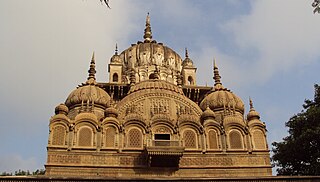
The Sahar, Sehariya, or Sahariya are an ethnic group in the state of Madhya Pradesh, India. The Saharias are mainly found in the districts of Morena, Sheopur, Bhind, Gwalior, Datia, Shivpuri, Vidisha and Guna districts of Madhya Pradesh and Baran district of Rajasthan.They are classified as Particularly vulnerable tribal group.

Dholpur is a city in the Dholpur district in Rajasthan state of India. It is situated on the left bank of the famous Chambal river. The city is the administrative headquarters of Dholpur District and was formerly seat of the Dholpur princely state.
Gird is a region of the Madhya Pradesh state in central India. It includes the districts of Bhind, Gwalior, Morena, Sheopur, and Shivpuri. Gwalior is the largest city in the region, and its historic center.

Sawai Madhopur district is a district of Rajasthan state in north-west India. Sawai Madhopur is the chief town and district headquarters. Sawai Madhopur district comes under Bharatpur division.

Bhind district is a district in the Chambal division of the Indian state of Madhya Pradesh. The town of Bhind is the district headquarters. Bhind District is situated in Chambal region in the northwest of the state. It is bounded by Agra, Etawah, Jalaun and Jhansi districts of Uttar Pradesh state to the north and the east, and the Madhya Pradesh districts of Datia to the south, Gwalior to the southwest, and Morena to the west. The geography of the district is characterised by uneven ravines, plain fertile fields and scanty forests. The total area of the district is 4,459 km2 (1,722 sq mi).

The Chambal Division is an administrative geographical unit of Madhya Pradesh state of India. A river by the name Chambal, a tributary of Yamuna River, forms the boundary between Rajasthan and Madhya Pradesh, in the upper part of the Chambal Division. Morena is the administrative headquarters of the division. As of 2012, the division consists of the three districts of Bhind district, Morena and Sheopur.

Guna district is one of the 52 districts of Madhya Pradesh in central India. Its administrative headquarters is Guna. The district has a population of 1,241,519. It has an area of 6390 km², and is bounded on the northeast by Shivpuri District, on the east by Ashoknagar District, on the southeast by Vidisha District, on the southwest by Rajgarh District, on the west and northwest by Jhalawar and Baran districts of Rajasthan state. The Sindh River flows northward along the eastern edge of the district, forming part of the boundary with Ashoknagar District, and the Parvati River flows northwestward through the southern portion of the district, forming part of the boundary with Baran District before flowing into Rajasthan.

Lalitpur District is one of the districts of Uttar Pradesh state of India. Lalitpur district is a part of Jhansi Division. Lalitpur is the main town and administrative headquarters. The district occupies an area of 5,039 km².

Shivpuri District is a district of Madhya Pradesh state of India. The town of Shivpuri is the district headquarters. National Highway 3 (NH-3) runs through the district.

Morena district is one of the 52 districts of the central Indian state of Madhya Pradesh, located in the Chambal division.

Sheopur is a city in Madhya Pradesh state of central India. It is the administrative headquarters of Sheopur District. Sheopur is linked by narrow gauge rail to Gwalior(No longer in operation). The town is traditionally famous for its wood carving. Chambal River is just 25 km, which forms the boundary between Rajasthan and MP states.

Banswara District has an area of 5,037 km2 (1,945 sq mi), which is 1.47% of Rajasthan state, India. The city of Banswara is the district headquarters. It is bounded on the north by Udaipur District, on the northeast by Pratapgarh District, on the east and southeast by Madhya Pradesh state, on the southwest by Gujarat state, and on the west by Dungarpur District.
Vijaypur also known as Bijeypur is a Town located in district Sheopur, Madhya Pradesh, India. This town is a part of the Vijaypur constituency and Morena constituency. It is located on the bank of the Kwari River. The town is one of the gateways to the Kuno Wildlife Sanctuary, the site selected as a second home to the Asiatic Lion and also for cheetah reintroduction in India.

Jaura is a town and a nagar panchayat in Morena district in the Indian state of Madhya Pradesh.
Raghogarh-Ruthiyai or Raghogarh-Vijaypur is a town and municipality in Guna district in the Indian state of Madhya Pradesh.
Sabalgarh is a municipality in Morena district in the Indian state of Madhya Pradesh.

Madhya Pradesh, often called the Heart of India, is a state in central India. Its capital is Bhopal. Madhya Pradesh was originally the largest state in India until November 1, 2000 when the state of Chhattisgarh was carved out. It borders the states Uttar Pradesh, Chhattisgarh, Maharashtra, Gujarat and Rajasthan.

Sheopur Assembly constituency is one of the 230 Vidhan Sabha constituencies of Madhya Pradesh state in central India. This constituency came into existence in 1951, as Sheopur Pohri, one of the 79 Vidhan Sabha constituencies of the erstwhile Madhya Bharat state.

Vijaypur Assembly constituency is one of the 230 Vidhan Sabha constituencies of Madhya Pradesh state in central India. This constituency came into existence in 1951, as Bijaypur, one of the 79 Vidhan Sabha constituencies of the erstwhile Madhya Bharat state.

Pohari Assembly constituency is one of the 230 Vidhan Sabha constituencies of Madhya Pradesh state in central India. This constituency came into existence in 1951, as Sheopur Pohri, one of the 79 Vidhan Sabha constituencies of the erstwhile Madhya Bharat state.
















